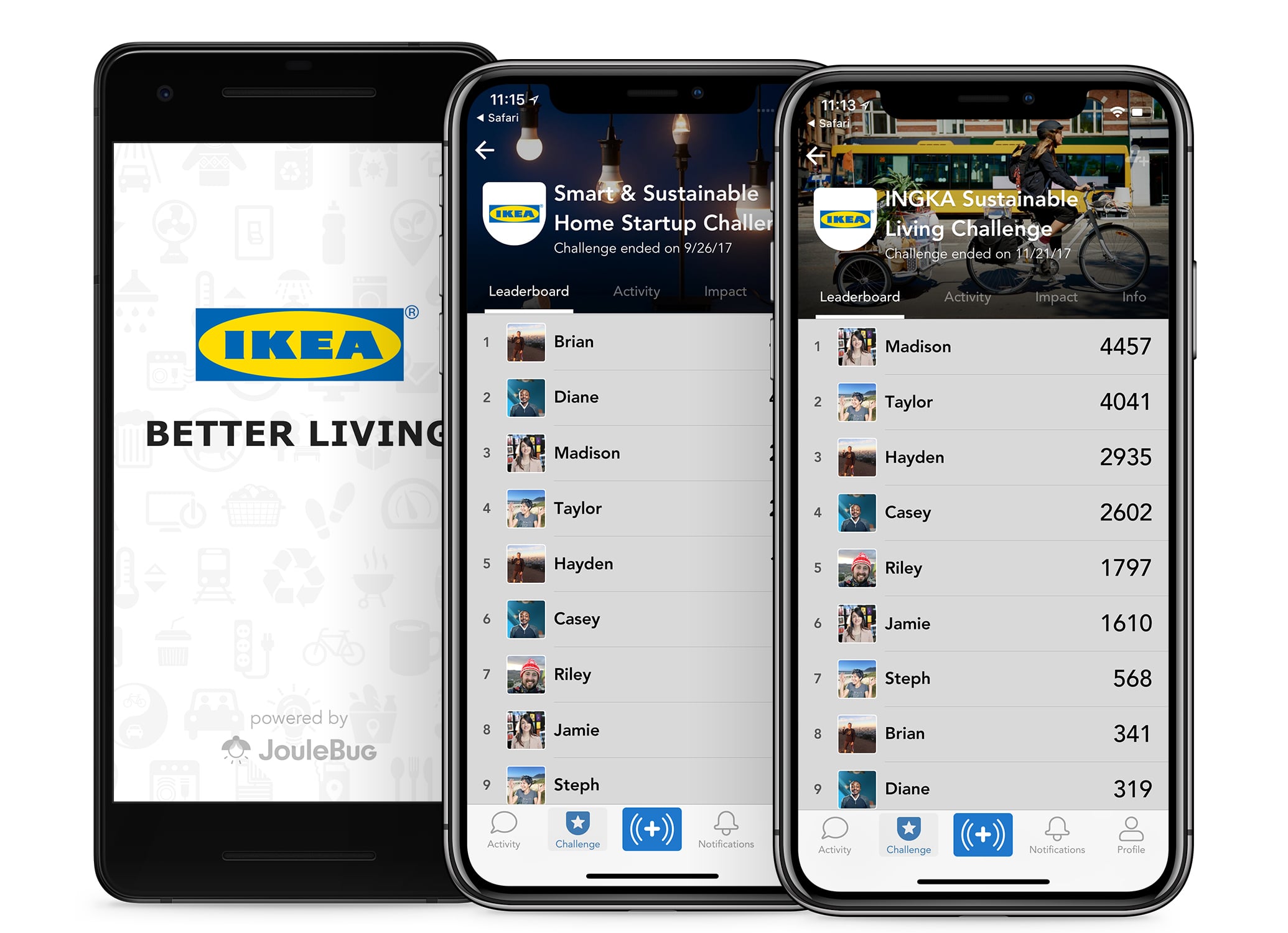Using competition as a tool in the JouleBug mobile app, we created a motivational feature that increased engagement. The result is a scalable product that works for small businesses up to global brands with hundreds of thousands of dollars in prizes.
My Contributions
Visual + Interaction Design
Product Strategy
Product Management
July 2017
The Challenge
We had accomplished our goal of creating JouleBug's reliable core experience to adopt and share real-world sustainable actions. However, JouleBug was struggling to keep most users engaged for any meaningful period of time. This was posing a problem both for JouleBug's growth, as well as customer launches.
Based on Behavior Change research, we felt that competition could be the motivational force needed to create reliable engagement. At this point, JouleBug's competition feature consisted of a leaderboard of the points scored by logging actions within the last 7 days. We set the goal of expanding upon this basic leaderboard to create Challenges that increased engagement, and served as a flexible product foundation to offer customers as JouleBug continued to search for the right product market fit.
Research & Approach
Based on feedback from JouleBug's users, we noticed a correlation between how active users were and how sustainably-minded or 'green' a user considered themselves. The most active and happy users were a minority at the upper end of the green scale. Meanwhile, a much larger group of moderately green users were having a positive experience, but were quickly losing interest in the app. This moderately green group was our focus representing the largest opportunity for improvement.
Early sketches
Early wireframes
Timing is Everything
One common theme in the feedback from our users was that the app's never-ending Leaderboard was fun at first, but eventually felt like a slog, causing interest to wane. In reaction, we introduced a simple but transformative change: a time limit.
Putting a finite start and finish to each Challenge shifted the competition feature from an endless ongoing theme, into discrete experiential units that could be customized and made unique. For users it created bursts of intense usage followed by healthy lulls in activity before returning for the next Challenge. For customers like cities, universities, and businesses, it created an opportunity to dovetail their initiative events with individual app experiences.
Teamwork makes the dream work
Based on our feedback from early iterations, we learned that many users would lose motivation during free-for-all competitions. They couldn't or wouldn't be able to keep up with the super-green users, and would become discouraged as they fell behind. In reaction to this, we added Team and Goal Challenges. These variations of Challenges allow casual players to add value to a winning effort, without having to keep up with the super users. Teams are also a versatile tool for customers. They can be used to unite existing departments or locations, or can be used to break up existing social circles.
Various animation studies for Goals and Stretch Goals.
Keep it Positive
We made sure to craft the end-of-Challenge experience so that no participants felt like they had lost. Medals are awarded to all participants, and can be collected in their trophy case. To avoid the feeling of consolation prizes, we created Specialization and Impact Medals, in addition to typical podium medals. These reward players who didn't score the most points and encourage other important factors in a Challenge, like consistency or encouraging teammates.
Competitive Medals
Specialization Medals
Goal Medals
Impact Medals
Challenge Variety
Variety and versatility are a key component of JouleBug's Challenge strategy. The ability to combine different rules, like free-for-all, teams, or goals, with targeted content focus (which actions count), gave JouleBug the ability to create a large number of unique challenges. We experimented constantly with JouleBug users and customer pilots to find combinations that worked best. The end-result was a year-round schedule of challenge content that could appeal to a much wider audience than before, without getting monotonous.
This versatility also made it easier for customers to pair their Challenges with external initiatives, unique to their organization. The intense nature of Challenge activity, combined with their customizability made them reliable launch vehicles for each new organization.
A typical year's worth of Challenges for JouleBug
Results
Challenges have been successful at increasing engagement and new sales. JouleBug runs new public Challenges every week, resulting in a 250% increase in activity. Challenges are the main feature of JouleBug's most popular product tier, for the team-building as much as the behavior change that they accomplish. One of the best examples of an organization using Challenges to motivate taking action is IKEA.
IKEA began their first Challenge in 2015, as a single store in Houston with co-workers competing against each other. Since then, they have expanded every year, growing to over 50 store and distribution centers on 3 continents. They've run hundreds of Challenges and given away hundreds of thousands of dollars in prizes to the winners.
250%
Increase in weekly Buzzes
with active Challenges
3x
Launch adoption for new organizations with active Challenges
35%
Year Over Year Growth
IKEA Challenge Engagement
“The Challenge was a big hit with our co-workers and we had great participation! We’ll definitely be repeating this activity.”
“The Challenge brought our employees together, enabling interaction between areas that never interact with each other.”













